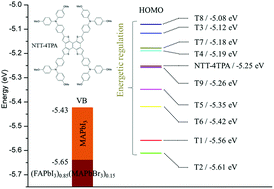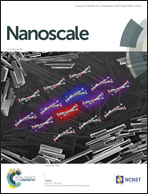How to design more efficient hole-transporting materials for perovskite solar cells? Rational tailoring of the triphenylamine-based electron donor†
Abstract
Designed with a symmetrical naphthatetrathiophene (NTT) core and triphenylamine (TPA)-based side arms, a series of novel organic small molecule hole-transporting materials are simulated for perovskite solar cells (PSCs) using density functional theory (DFT) and time-dependent DFT (TD-DFT) methods. As a fundamental understanding, the energy level alignments and the charge transport behavior are explored for their potential applications. Our results show that, adding an oxygen-bridge between the neighboring phenyl groups of TPA side arms makes the highest occupied molecular orbital (HOMO) levels up-shift, whereas the carbon–carbon single bond stabilizes the HOMOs by about 0.3–0.4 eV. By structural tailoring of the TPA side arms, the HOMO levels of newly designed molecules range from −5.08 eV to −5.61 eV, which provides more possibilities for the interfacial energy regulation. Meanwhile, our results also indicate that the quasi-planar molecular architecture and the delocalized frontier molecular orbitals can effectively enhance the electronic coupling between adjacent molecules. In addition, the reorganization energies are distinctly lowered in the cases of the mixed carbon–carbon bond and oxygen-bridge, and the double oxygen-bridge models. As a result, these molecules with the additional carbon–carbon bond and oxygen-bridge exhibit high hole mobilities. Several promising candidates are proposed toward more efficient PSCs, and more importantly, this work offers some new insights for the design of organic small molecule materials.



 Please wait while we load your content...
Please wait while we load your content...